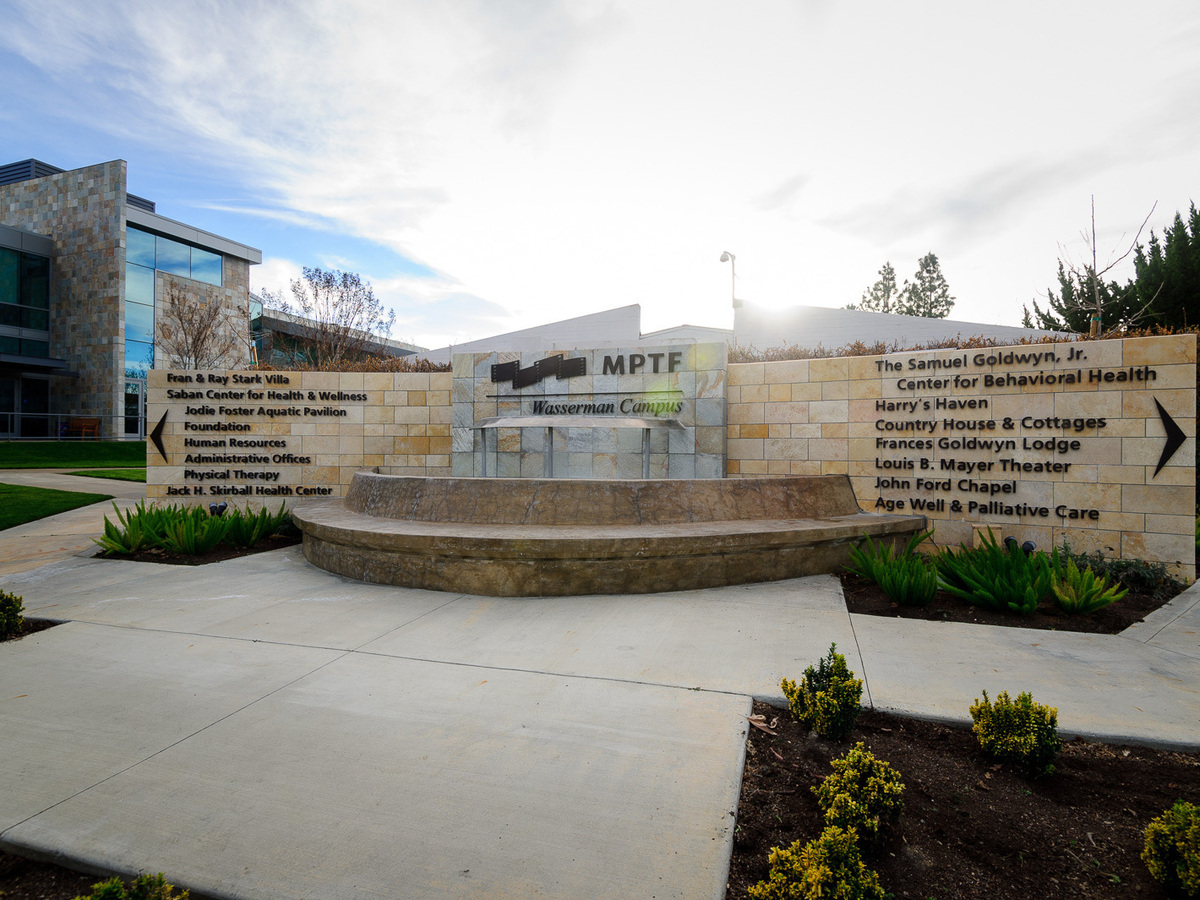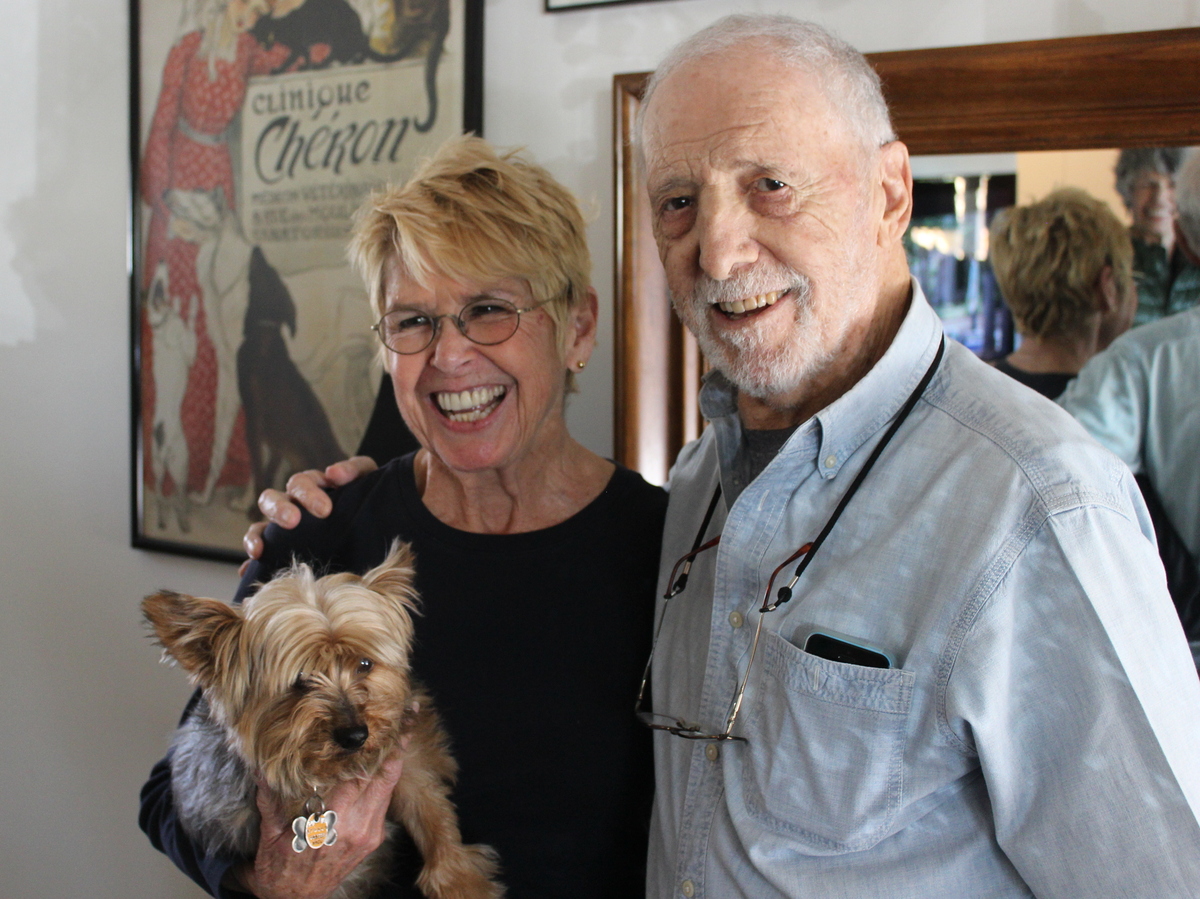Motion Picture and Televsion Fund Review From Employees

Connie Sawyer, 103, got into show business concern when she was 8. She's lived on the Picture and Television Fund campus since 2004. Daniel Hajek /NPR hide explanation
toggle caption
Daniel Hajek /NPR

Connie Sawyer, 103, got into bear witness business organisation when she was eight. She'southward lived on the Moving picture and Television Fund campus since 2004.
Daniel Hajek /NPR
You don't expect a bunch of 80-pluses to exist working up a sweat, only at the Movement Flick and Tv Fund gym, they do. An exercise teacher encourages them. "Squeeze your tush. ... Tushies, tushes, tushies. Squeeze your buns," she urges.
At this retirement community in Woodland Hills, Calif., less than an 60 minutes from Los Angeles, the motion picture and TV manufacture has been taking care of its own for decades. The Move Movie and Tv set Fund'due south 48 acres include gardens, fountains, cottages and apartments for independent residents, plus assisted living facilities with skilled nurses and dementia care.

The Motion Picture and Television Fund's 48 acres include gardens, fountains, assisted living facilities and homes for independent residents. Courtesy of the Motion Motion picture and Tv Fund hide caption
toggle explanation
Courtesy of the Move Picture and Television receiver Fund

The Motion Picture and Television receiver Fund's 48 acres include gardens, fountains, assisted living facilities and homes for contained residents.
Courtesy of the Motion Picture and Television receiver Fund
Resident Connie Sawyer, 103, has lived here since 2004. She got into show business organization when she was viii. "I worked in vaudeville and nightclubs. I played every saloon in the business organisation," she says. She was in a Broadway show called A Pigsty in the Head, which defenseless the attention of one of Frank Sinatra's managers. Sawyer says the director told Sinatra, " 'You lot gotta buy that property. It'll brand a wonderful movie.' He said, 'Buy it! Bring the author.' " But the writer wouldn't get without Sawyer, who created her stage character — a funny, tipsy gal who got lots of laughs. And then the manager chosen Sinatra back and, according to Sawyer, "He said, 'Bring the drunk!' "
Today, Sawyer is withal working — she did a Super Bowl ad for Contrivance terminal year. She says the secret of her longevity is "Movement. Don't sit down on the couch. All my life, I played golf, I swam. And fifty-fifty here, I go to the practise class."
Sawyer takes special swim classes for her arthritis in a pool Jodie Foster contributed to the campus. (Water therapy helped the actress' female parent, and she wanted to assistance others.) The community as well offers a weekly writing workshop called the Gray Quill Club. At the group's 115th coming together, somebody'southward Labrador snoozes while screenwriter Peter Dunne, a volunteer, runs the evidence. 14 residents sit down effectually a long table with manuscripts they're working on — memoirs, poems, even promos they may record at the home'southward 24/7 airtight circuit Boob tube station. That same station also arrogance resident-made brusk films and recorded talks.

H2o therapy helped Jodie Foster's mother, so the extra contributed a pool to the Woodland Hills campus. Courtesy of the Motion Moving picture and Television Fund hide caption
toggle caption
Courtesy of the Motility Picture and Television Fund

Water therapy helped Jodie Foster's female parent, so the actress contributed a pool to the Woodland Hills campus.
Courtesy of the Motion Pic and Idiot box Fund
The Motility Picture and Television set Fund is home to 200-plus residents who once worked on screen, behind cameras, in production rooms and in secretarial pools — industry people in an extremely fickle manufacture. Fund President Bob Beitcher says most were freelancers.
"They might exist working on [a] Television receiver series that [is] supposed to be 13 episodes; half-dozen weeks into it, it gets canceled, they're out of piece of work," he says. "They work in a feature film, feature films end and then they're out of piece of work. So it really is an manufacture where you never know what lies in your time to come."
The founders of the fund, some of film's greatest early stars, decided to create some stability. In 1921, they formed a fund and so working industry folks could make contributions to those without piece of work.
"That was the vision of Mary Pickford, Douglas Fairbanks, Charlie Chaplin, D.W. Griffith," Beitcher says. "And they say that if you worked on a Mary Pickford film, she had a piddling galvanized saucepan on the prepare with a little flag on it and if you lot were lucky enough to be working that day, she expected you to drop something in the bucket to reflect your gratitude for getting paid for the work."
All these years later, the industry still pitches in. Fund chairman and DreamWorks Animation head Jeffrey Katzenberg has raised virtually half a billion dollars in the past 23 years. The coin supports thousands of industry people in need, including residents who can't beget the $three,000 to $8,000 monthly fee.
Ken Scherer, CEO of the Motion Picture and Television Fund foundation, says many facilities on campus are named for the film giants who endowed them, like Kirk Douglas.
"He would bout the Alzheimer'south unit that he helped build, and then he would come and take dinner," Scherer says. "And inevitably a resident would walk upwards and say to Kirk Douglas, 'Y'all were in my final picture.' At present that person could've been a grip [lighting and rigging technician], only in his head, Kirk Douglas worked on his flick."

Madeline Smith and Tony Lawrence met and married on the Motion Picture show and Television set Fund campus. Daniel Hajek /NPR hide caption
toggle explanation
Daniel Hajek /NPR

Madeline Smith and Tony Lawrence met and married on the Movement Moving picture and Telly Fund campus.
Daniel Hajek /NPR
Moving-picture show and TV giants have also used the campus' facilities — Norma Shearer and Mary Astor lived there. Hattie McDaniel died there, and comedian Bud Abbott came in for physical therapy.
More recently, a meeting at the campus was nearly movielike: TV writer Tony Lawrence, 87, moved to the campus 11 years ago with his wife, Nancy, who had Alzheimer's. They had been married fifty years when she died. "And that'due south why it was and so amazing and such a miracle to notice ... someone like Madi in my life," he says.
Madi is Madeline Smith, 75, a former NBC administrative banana who moved to the campus in 2014. A year after, she and Lawrence got married in the rose garden. On the couch in their small-scale cottage, the newlyweds sit then close together you couldn't fit a piece of paper between them. This is what, in showbiz, you'd call a happy ending. Especially since neither wanted to move here.
"I thought, 'Oh no, this is a bunch of onetime people. I don't desire to live here,' " Smith recalls
"Of course, everybody says that earlier they come here," Lawrence adds. But then y'all arrive and, as Lawrence puts information technology, "You detect out you're one of the sometime people."
Source: https://www.npr.org/2016/03/08/469532470/a-retirement-community-where-hollywood-takes-care-of-its-own
0 Response to "Motion Picture and Televsion Fund Review From Employees"
Post a Comment